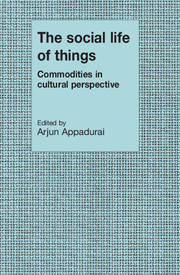Book contents
- Frontmatter
- Contents
- Contributors
- Foreword
- Preface
- Part I Toward an anthropology of thing
- Part II Exchange, consumption, and display
- Part III Prestige, commemoration, and value
- 5 Varna and the emergence of wealth in prehistoric Europe
- 6 Sacred commodities: the circulation of medieval relics
- Part IV Production regimes and the sociology of demand
- Part V Historical transformations and commodity codes
- Index
6 - Sacred commodities: the circulation of medieval relics
Published online by Cambridge University Press: 05 June 2014
- Frontmatter
- Contents
- Contributors
- Foreword
- Preface
- Part I Toward an anthropology of thing
- Part II Exchange, consumption, and display
- Part III Prestige, commemoration, and value
- 5 Varna and the emergence of wealth in prehistoric Europe
- 6 Sacred commodities: the circulation of medieval relics
- Part IV Production regimes and the sociology of demand
- Part V Historical transformations and commodity codes
- Index
Summary
An examination of sacred relics as commodities in the Middle Ages may seem to be pushing the definition of commodities as “goods destined for circulation and exchange” to an extreme. Could one reasonably describe a human body or portions thereof as destined for circulation? Can we really compare the production and circulation of saints' remains to that of gold in prehistoric Europe, cloth in pre-Revolutionary France, or qat in northeastern Africa? The differences are of course great. Nevertheless, although relics were almost universally understood to be important sources of personal supernatural power and formed the primary focus of religious devotion throughout Europe from the eighth through the twelfth centuries, they were bought and sold, stolen or divided, much as any other commodity was. As a result the world of relics may prove an ideal if somewhat unusual microcosm in which to examine the creation, evaluation, and circulation of commodities in traditional Europe. Like slaves, relics belong to that category, unusual in Western society, of objects that are both persons and things (Kopytoff, Chapter 2). Reflecting on the production, exchange, sale, and even theft of sacred relics enables one better to understand the cultural parameters of commodity flow in medieval civilization.
“Medieval civilization” is an extremely imprecise designation, obscuring rather than defining a wide variety of distinct cultural and social traditions that appeared across Europe over a period of a thousand years. The specific period I shall discuss embraces the Carolingian and post-Carolingian eras, roughly 750–1150, and the region will be generally the Latin West, with an emphasis on those areas that had formed part of the Carolingian Empire.
- Type
- Chapter
- Information
- The Social Life of ThingsCommodities in Cultural Perspective, pp. 169 - 192Publisher: Cambridge University PressPrint publication year: 1986
- 110
- Cited by

